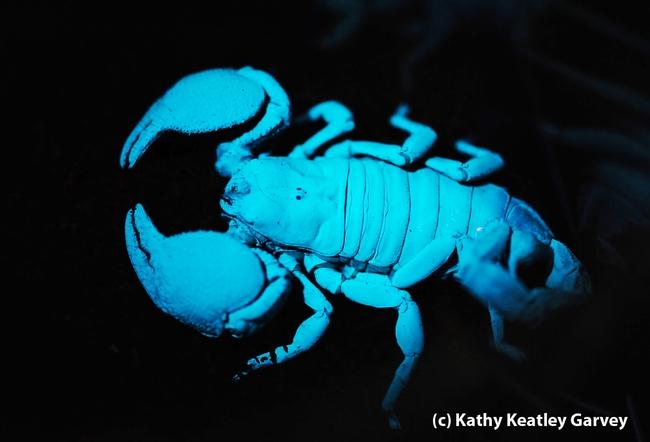Scorpions--to fear or to revere?
The Bohart Museum of Entomology's open house last Sunday drew visitors of all ages who marveled at the scorpions glowing under ultraviolet light.
UC Davis entomology major Alexander Nguyen flashed a UV light on the critters as his audience watched in amazement.
Most--but not all--of the world's scorpions glow under ultraviolet light, says Lynn Kimsey, director of the Bohart Museum, which houses more than seven million insect specimens.
Scorpions are not insects, but arachnids, the same as spiders. Ranging in size from 9 mm to 21 mm, scorpions have eight legs (arachnid alert!) and grasping claws that help conquer their prey. But it's their venom that kills. And all scorpions possess venom.
UC Davis entomologist Bruce Hammock and his lab made the news back in 2003 when they published a study that showed that scorpions produce two venoms: a pre-venom to deter predators and immobilize small prey, and then the good stuff, the powerful venom that's meant to kill.
It's like saving the best for last or waiting for the venom glands to pump and reload, so to speak.
So, why do they glow?
Scientists believe it's because of the fluorescent material found in the scorpion's hard outer covering.
"The fact that they glow serves no physiological function," said Bohart senior museum scientist Steve Heydon. "It's probably a quirk of chemical makeup."
Great quote..."a quirk of chemical makeup."
Attached Images:

Scorpion glowing under ultraviolet light at the Bohart Museum of Entomology. (Photo by Kathy Keatley Garvey)

UC Davis entomology undergraduate student Alexander Nguyen flashes a UV light on a scorpion, as Professor Demosthenes Pappagianis, M.D., Ph.D., of Medical Microbiology and Immunology, watches. (Photo by Kathy Keatley Garvey)